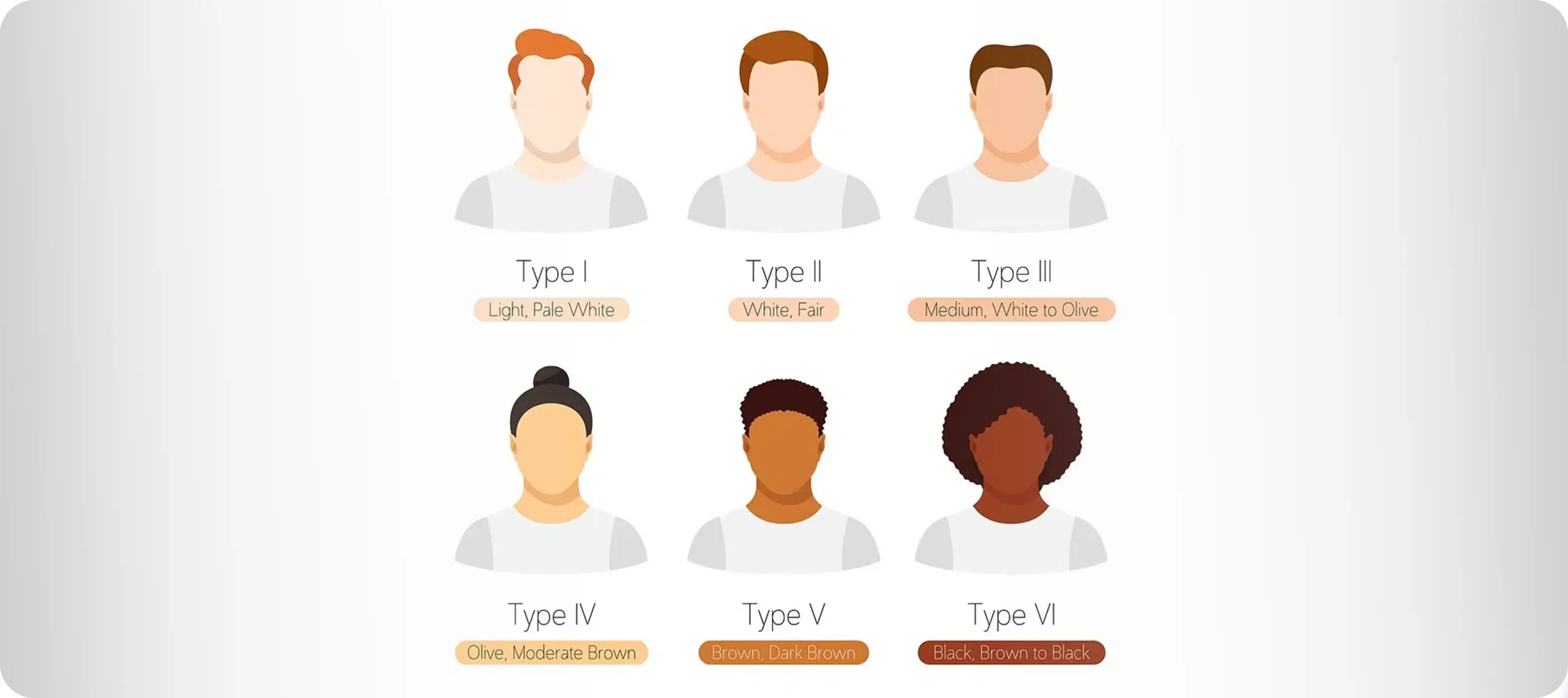Have you ever wondered why your skin reacts differently to the sun compared to someone else’s? Or why certain skincare treatments work brilliantly for your friend but not quite the same for you? The answer may lie in your skin type—and not just whether it’s oily, dry or combination. One of the most important yet often overlooked classifications in dermatology is the Fitzpatrick Skin Type Scale. This scale isn’t just academic; it’s a practical tool that plays a vital role in how dermatologists assess, diagnose and treat your skin.
In this article, we’ll explore the Fitzpatrick Skin Type Scale in depth—how it was developed, what each type means, and why it matters so much in both clinical and cosmetic dermatology. Whether you’re considering laser treatment, planning a skincare routine, or simply trying to understand how your skin responds to sunlight, this guide will help you gain clarity and confidence about your skin.
What Is the Fitzpatrick Skin Type Scale?
The Fitzpatrick Skin Type Scale is a classification system that was developed in 1975 by Dr Thomas B Fitzpatrick, a dermatologist at Harvard Medical School. His goal was to create a straightforward way to estimate how different types of skin would react to ultraviolet (UV) light, especially in terms of burning and tanning.
Instead of focusing on race or ethnicity, which are too broad and imprecise, the scale is based on observable skin reactions—particularly in response to sun exposure. It classifies skin into six types, from very fair (Type I) to deeply pigmented dark brown or black (Type VI), with each category providing insight into a person’s susceptibility to sunburn and capacity to tan.
This scale isn’t just a theoretical framework. It has real-world applications across dermatology, from assessing skin cancer risk to selecting the safest cosmetic treatments. Essentially, it’s a cornerstone for personalised skin care.
The Six Fitzpatrick Skin Types Explained
Type I – Very Fair Skin
If you have extremely fair skin that appears porcelain or pale white, with light-coloured eyes—often blue, grey, or green—and hair that is naturally blonde or red, you most likely fall into Type I. Individuals with this skin type tend to have very low levels of melanin, the pigment responsible for absorbing and deflecting UV rays. As a result, exposure to sunlight—even for short periods—almost always leads to burning, with virtually no ability to tan. This characteristic makes Type I skin among the most vulnerable to sun-induced damage.
From a dermatological perspective, Type I skin requires a highly proactive approach to sun protection. Broad-spectrum sunscreen with a high SPF, physical barriers like hats and clothing, and avoidance of peak UV hours are essential daily practices. Due to the skin’s reduced ability to produce protective pigmentation, any unprotected exposure can quickly result in erythema, blistering, or long-term cellular damage. This skin type is also more prone to developing actinic keratoses, a pre-cancerous condition that may lead to squamous cell carcinoma if left untreated.
When it comes to dermatological treatments, Type I skin must be handled with great caution. Aggressive chemical peels, intense pulsed light (IPL), and some types of laser therapies can cause prolonged redness, irritation, or even scarring. Tailored treatment plans with lower settings and slower progression are often required. Moreover, because inflammation is more visible in fair skin, conditions like rosacea and contact dermatitis tend to present more prominently and may need more careful management.
Type II – Fair Skin
Type II skin is also quite fair but usually has slightly more pigmentation than Type I. People in this category often have light brown or blonde hair, blue or hazel eyes, and a skin tone that may burn easily but is capable of developing a light tan over time—albeit with difficulty. This skin type is still considered UV-sensitive and typically requires daily sun protection to avoid acute and long-term damage.
While the melanoma risk remains elevated, there is marginally more natural protection in Type II skin than in Type I. However, repeated sun exposure can still lead to cumulative damage such as fine lines, pigment irregularities, and other signs of photoageing. Chronic exposure without protection can also promote the development of lentigines (commonly known as sun spots) and increase the likelihood of precancerous lesions. For those in this category, annual skin checks are highly advisable.
From a cosmetic standpoint, this skin type responds relatively well to certain dermatological treatments but still requires a conservative approach. Light chemical peels and fractional laser treatments may be effective for addressing sun damage and texture concerns, but close monitoring is essential. Post-treatment care should emphasise barrier repair and moisturisation to reduce the risk of prolonged erythema or sensitivity. Pigment-related reactions are less likely than in darker types, but they can still occur if the treatment plan is not properly tailored.
Type III – Medium or Light Olive Skin
Type III skin usually presents as light to medium olive in tone and is common among individuals of Southern European, some Middle Eastern, and Latin American descent. This type of skin has a greater capacity to tan but is still susceptible to sunburn with extended exposure. While it represents a midpoint on the Fitzpatrick Scale, this doesn’t mean it’s immune to UV damage—it just means the signs might appear more slowly or subtly.
One of the notable features of Type III skin is its intermediate melanin level, which offers a degree of built-in sun protection. This makes the skin less likely to suffer from immediate sunburn compared to Types I and II. However, repeated exposure without adequate protection can still result in cumulative cellular damage that may not be visible until years later. Fine lines, uneven skin tone, and deeper-set wrinkles can gradually develop, along with an increased risk of certain types of skin cancer, particularly when genetic predispositions are present.
Dermatological procedures for Type III skin typically enjoy a broader safety margin compared to the lighter types. However, there’s still a need for cautious parameter settings during laser or light-based therapies to avoid issues like post-inflammatory hyperpigmentation. Treatments aimed at pigmentation, such as melasma or sun spots, must be performed with precision, especially since this skin type can be reactive under certain conditions. A well-rounded skincare routine that includes antioxidants and regular sunscreen use can support both treatment outcomes and long-term skin health.
Type IV – Olive or Light Brown Skin
Type IV skin typically appears as light brown or true olive in tone and is common among individuals of South Asian, Middle Eastern, and Mediterranean backgrounds. It has a strong capacity to tan and rarely burns under moderate sun exposure. The increased melanin content offers a significant protective buffer against UV radiation, making this type less prone to the immediate signs of sun damage—but it also comes with its own challenges.

Because Type IV skin tans easily, many people underestimate the need for sun protection. While it might not burn as obviously as fairer skin types, UV radiation can still trigger cellular damage beneath the surface. One of the biggest concerns in this group is the tendency toward pigmentary disorders, such as melasma, which can be exacerbated by sun exposure or hormonal fluctuations. Skin cancer risk is lower overall, but it still exists—especially in areas that receive chronic sun exposure over many years.
In clinical dermatology, Type IV skin demands a nuanced approach. While it tolerates certain treatments better than lighter types, the risk of hyperpigmentation or even hypopigmentation remains a real concern, particularly following ablative procedures. Any trauma to the skin—whether from acne, surgery, or cosmetic treatments—can leave long-lasting marks if not managed appropriately. Therefore, dermatologists often recommend gentle yet effective options like superficial peels or radiofrequency treatments, always followed by a rigorous post-treatment care plan.
Type V – Brown Skin
Type V skin typically appears as brown or deep olive and is commonly found among individuals of African, Caribbean, South Asian, and Middle Eastern heritage. This skin type rarely burns and almost always tans deeply, owing to its high melanin concentration. This built-in protection from UV radiation offers significant advantages, but it doesn’t eliminate the need for careful skin management.
Although sunburn is uncommon, the misconception that sunscreen isn’t necessary in Type V skin can lead to complacency. UV damage may not show up as burns, but it can manifest as uneven skin tone, photodamage, and textural changes over time. Moreover, while less common than in fairer types, skin cancer can still occur, particularly in less obvious areas like the soles of the feet or beneath the nails. Delayed diagnosis in these areas can pose serious health risks.
From a procedural standpoint, Type V skin is more prone to complications such as keloid formation and post-inflammatory hyperpigmentation. Laser treatments, especially those targeting pigment or vascular lesions, must be carefully selected and expertly administered. Even treatments aimed at smoothing skin texture—like microneedling or dermabrasion—must be approached with caution to prevent unintended side effects. A conservative strategy, often combining topical agents with non-ablative therapies, tends to yield the safest and most effective outcomes.
Type VI – Deeply Pigmented Dark Brown or Black Skin
Type VI skin represents the darkest end of the pigmentation spectrum and is most commonly found among individuals of African descent. With the highest concentration of melanin, this skin type offers robust natural protection against UV-induced burns and some types of skin cancer. It tans extremely easily and rarely, if ever, burns under normal environmental conditions.
Despite this resilience, Type VI skin is not immune to dermatological concerns. In fact, it presents its own unique set of challenges, particularly in the realm of pigmentation. Conditions such as vitiligo, lichen planus pigmentosus, and PIH are frequently encountered and often more distressing due to the pronounced contrast between affected and unaffected areas. Furthermore, because skin cancers in this group often arise in less sun-exposed regions, they are frequently diagnosed at a later stage, which can complicate treatment.
Clinical treatment of Type VI skin requires expertise in ethnic dermatology. The skin’s reactivity means that any invasive or energy-based treatment must be chosen with extreme caution. Chemical peels, for example, must be limited to superficial depths, and laser settings must be fine-tuned to avoid causing hypo- or hyperpigmentation. Topical treatments to even out tone or manage chronic conditions often form the foundation of care. Preventative strategies, including sunscreen, regular skin checks, and tailored skin care, are essential for maintaining long-term skin health.
However, there’s a common misconception that dark skin is immune to sun damage—this isn’t true. Skin cancer can and does occur, although it’s often diagnosed later, which can complicate treatment. In addition, dermatological concerns like pigmentation disorders, vitiligo, and scarring tendencies are more pronounced and must be handled with care and expertise.
Why the Fitzpatrick Scale Matters in Dermatology
The real value of the Fitzpatrick Skin Type Scale lies in its clinical utility. It’s not just about identifying your skin tone; it’s about tailoring your treatment, protection, and prevention strategies to suit your skin’s unique needs.
Skin Cancer Risk Assessment
Different skin types carry varying levels of risk for developing skin cancer. For instance, Types I and II are at much greater risk than Types V and VI. This means that dermatologists use the scale as a predictive tool, advising higher-risk individuals to undertake more regular screenings and stricter sun protection measures.
Guiding Cosmetic and Medical Treatments
Laser treatments, peels, microneedling, and other procedures must be chosen and calibrated carefully based on skin type. Higher Fitzpatrick types have a greater risk of pigmentation changes or scarring if inappropriate methods are used. Conversely, lighter skin types may require gentler protocols to prevent burns or irritation.
Even treatments as common as acne therapy can be influenced by your Fitzpatrick type. Topical retinoids, for example, might be too harsh for some skin tones, while others tolerate them well.
Planning Safe Sun Exposure
Knowing your Fitzpatrick type helps you understand your natural level of sun protection. While everyone should use sunscreen, those with lower types need to be far more vigilant. Tanning beds, sunbathing, and outdoor activities come with very different risks depending on your position on the scale.

Personalising Skincare Regimens
From moisturisers to exfoliants, your skin’s sensitivity plays a huge role in product selection. Type I skin may be prone to redness and dryness, requiring soothing ingredients like ceramides and niacinamide. Type VI may be more resistant to dryness but struggle with uneven tone or oil production. The Fitzpatrick Scale helps guide dermatologists and skincare professionals in recommending the right ingredients and formulations.
Common Misconceptions About Skin Type and Colour
It’s easy to confuse skin type with ethnicity or to assume that darker skin needs no protection from the sun. In reality, melanin does provide some natural defence, but it’s not a free pass. Even deeply pigmented skin can develop UV damage, albeit in different patterns—often showing up as uneven tone or thickened skin rather than traditional sunburn.
Another common myth is that the Fitzpatrick Scale is static. In fact, certain factors like medication, hormonal changes, and long-term sun exposure can slightly alter your skin’s behaviour over time. This is why a one-off assessment might not be sufficient, especially if you’re considering treatments that require precision and care.
How Dermatologists Use the Scale in Practice
When you visit a dermatologist, they’ll often ask you questions about how your skin responds to sunlight. Do you burn after ten minutes outside? Do you tan easily after a few hours in the sun? These answers help determine your Fitzpatrick type, which then informs a wide range of decisions.
For example, a dermatologist may choose a specific type of laser wavelength, power setting, or even a completely different procedure depending on your classification. They may also use the scale to forecast how your skin might heal or react to medication. It’s not just about aesthetics—it’s about ensuring safety, efficacy, and long-term results.
In clinical trials, the Fitzpatrick Scale is often used to categorise participants, ensuring that new treatments are tested across a diverse range of skin types. This helps ensure that therapies are both safe and effective for everyone, not just for those with lighter skin.
Final Thoughts
The Fitzpatrick Skin Type Scale might seem like a simple classification system at first glance, but its implications are wide-ranging and deeply significant. Whether you’re planning a cosmetic procedure, assessing your skin cancer risk, or just trying to understand how your skin reacts to the world around it, this scale can offer clarity and confidence.
Understanding your Fitzpatrick type is not just about colour—it’s about how your skin behaves, reacts and heals. It provides a personalised lens through which to approach everything from sun protection to skincare treatments, allowing for better choices and healthier outcomes.
So, the next time you reach for sunscreen or book a dermatology appointment, take a moment to think about your skin’s unique characteristics. With the help of the Fitzpatrick Scale, you’re not just taking care of your skin—you’re empowering yourself with knowledge that can last a lifetime. If you’d like to learn more about your skin type and receive tailored advice, feel free to contact us at The London Dermatology Centre to book a consultation with one of our expert dermatologists.
